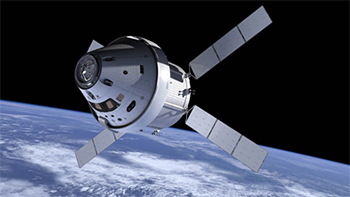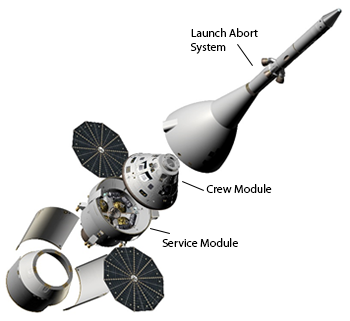InTrans / Dec 15, 2014
Exploring space
Go! Magazine
 posted on December 15, 2014
posted on December 15, 2014
On December 5, 2014, NASA’s spacecraft Orion lifted off into space. In a mission known as Exploration Flight Test-1 (ETF-1), NASA launched an unmanned craft 3,600 feet into the air, which returned to Earth that same day. But first, let’s look at the progress of space travel leading up to this historic moment.
History of flight
The first person to reach outer space was Soviet Union’s Yuri Gagarin in 1961. One month later, in May 1961, Alan Shepard of the United States completed a spaceflight at an altitude of 115 miles. Then in 1965, Yuri Gagarin was the first person to ever leave the spacecraft and venture into space. And one cannot forget a historic moment for the United States: On July 20, 1969, Apollo 11 Commander Neil Armstrong landed on the moon. Armstrong stepped onto the moon’s surface for the first time and said, “That’s one small step for man, one giant leap for mankind.”

In 1981, NASA created a partially reusable spaceship called the Space Shuttle, which would be used for nearly 30 years. Over the course of 30 years, there were 135 missions launched from the Kennedy Space Center in Cape Canaveral, Florida. Of these, five manned orbiters were built: Columbia, Challenger, Discovery, Atlantis, and Endeavor. Tragically, Challenger and Columbia were destroyed in mission accidents in 1986 and 2003 respectively, killing 14 astronauts. After the final flight of Endeavor in 2011, the Space Shuttle was retired.
Why is this important?
So you may be asking yourself, “Why do we care so much about space exploration?” Some have even asked “Why don’t we spend more money on exploring our Earth’s oceans?” (See “Exploring our oceans” for the full story). Simply put, space exploration is motivated by human curiosity, human inspiration, and the belief in human destiny somewhere other than Earth.
As Stephen Hawking once said, “Our only chance of long-term survival is not to remain lurking on planet Earth, but to spread out into space.” Some people, like Hawking, believe that one day humans will have to live on another planet other than Earth.
What is Orion?
The retirement of the Space Shuttle was a long-term plan which sought to send spaceships beyond Earth’s orbit. NASA’s goal is to send humans to near-Earth asteroids by 2025, and to Mars and its moons by the mid-2030s. The launch of Orion is the next phase of space exploration since the retirement of the Space Shuttle.

Photo from Wikipedia.
The next manned space flight will be a lunar orbit trip, which is scheduled for 2021. Orion is made up of three separate parts: the launch abort system, crew module, and the service module. The service module helped push the speed of Orion up to 20,000 mph. To put that into perspective, that speed is 26 times the speed of sound, and 36 times the speed of an airplane.

Once Orion hit its maximum altitude of 3600 miles, the crew module separated from the service module and began descending back to Earth. The crew module deployed parachutes and landed safely into the Pacific Ocean on the same day it was launched. To put 3600 miles into perspective, the International Space Station, placed in 1998 and still orbiting the Earth, is located only 268 miles from Earth. Orion is one of the first missions that leads towards deep space exploration.
Flying forward: What’s next for space travel?
Orion is so incredibly important, because it signifies the next era of space exploration that may eventually lead to man landing on Mars. From then, we can only dream of what planet we will hope to land on next. Did you know that space travel is headed down a path that may allow non-astronauts to explore space?
Dennis Tito, an American engineer and millionaire, became the first “space tourist” in 2001. Tito paid about $20 million for an eight-day trip to the International Space Station. Though $20 million seems a bit extreme, it is reported that in the future prices as low as $200,000 may buy a space tourist a ticket into space. Just how much would you be willing to pay to explore space?
Related links
http://www.nasa.gov/orion/#.VI7z4DHF9HA
http://gizmodo.com/5921476/orion-capsulesay-hello-to-the-future-of-manned-space-flight
By Jackie Nester, Go! Staff Writer